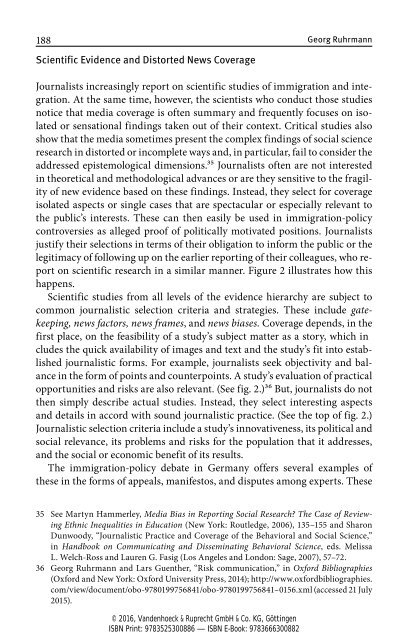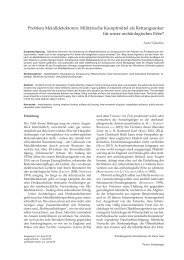Media and Minorities
9783666300882_ruhrmann_media_ebook_034247
9783666300882_ruhrmann_media_ebook_034247
You also want an ePaper? Increase the reach of your titles
YUMPU automatically turns print PDFs into web optimized ePapers that Google loves.
188<br />
Georg Ruhrmann<br />
Scientific Evidence <strong>and</strong> Distorted News Coverage<br />
Journalists increasingly report on scientific studies of immigration <strong>and</strong> integration.<br />
At the same time, however, the scientists who conduct those studies<br />
notice that media coverage is often summary <strong>and</strong> frequently focuses on isolated<br />
or sensational findings taken out of their context. Critical studies also<br />
show that the media sometimes present the complex findings of social science<br />
research in distorted or incomplete ways <strong>and</strong>, in particular, fail to consider the<br />
addressed epistemological dimensions.35 Journalists often are not interested<br />
in theoretical <strong>and</strong> methodological advances or are they sensitive to the fragility<br />
of new evidence based on these findings. Instead, they select for coverage<br />
isolated aspects or single cases that are spectacular or especially relevant to<br />
the public’s interests. These can then easily be used in immigration-policy<br />
controversies as alleged proof of politically motivated positions. Journalists<br />
justify their selections in terms of their obligation to inform the public or the<br />
legitimacy of following up on the earlier reporting of their colleagues, who report<br />
on scientific research in a similar manner. Figure 2 illustrates how this<br />
happens.<br />
Scientific studies from all levels of the evidence hierarchy are subject to<br />
common journalistic selection criteria <strong>and</strong> strategies. These include gatekeeping,<br />
news factors, news frames, <strong>and</strong> news biases. Coverage depends, in the<br />
first place, on the feasibility of a study’s subject matter as a story, which in<br />
cludes the quick availability of images <strong>and</strong> text <strong>and</strong> the study’s fit into established<br />
journalistic forms. For example, journalists seek objectivity <strong>and</strong> balance<br />
in the form of points <strong>and</strong> counterpoints. A study’s evaluation of practical<br />
opportunities <strong>and</strong> risks are also relevant. (See fig. 2.)36 But, journalists do not<br />
then simply describe actual studies. Instead, they select interesting aspects<br />
<strong>and</strong> details in accord with sound journalistic practice. (See the top of fig. 2.)<br />
Journalistic selection criteria include a study’s innovativeness, its political <strong>and</strong><br />
social relevance, its problems <strong>and</strong> risks for the population that it addresses,<br />
<strong>and</strong> the social or economic benefit of its results.<br />
The immigration-policy debate in Germany offers several examples of<br />
these in the forms of appeals, manifestos, <strong>and</strong> disputes among experts. These<br />
35 See Martyn Hammerley, <strong>Media</strong> Bias in Reporting Social Research? The Case of Reviewing<br />
Ethnic Inequalities in Education (New York: Routledge, 2006), 135–155 <strong>and</strong> Sharon<br />
Dunwoody, “Journalistic Practice <strong>and</strong> Coverage of the Behavioral <strong>and</strong> Social Science,”<br />
in H<strong>and</strong>book on Communicating <strong>and</strong> Disseminating Behavioral Science, eds. Melissa<br />
L. Welch-Ross <strong>and</strong> Lauren G. Fasig (Los Angeles <strong>and</strong> London: Sage, 2007), 57–72.<br />
36 Georg Ruhrmann <strong>and</strong> Lars Guenther, “Risk communication,” in Oxford Bibliographies<br />
(Oxford <strong>and</strong> New York: Oxford University Press, 2014); http://www.oxfordbibliographies.<br />
com/view/document/obo-9780199756841/obo-9780199756841–0156.xml (accessed 21 July<br />
2015).<br />
© 2016, V<strong>and</strong>enhoeck & Ruprecht GmbH & Co. KG, Göttingen<br />
ISBN Print: 9783525300886 — ISBN E-Book: 9783666300882







